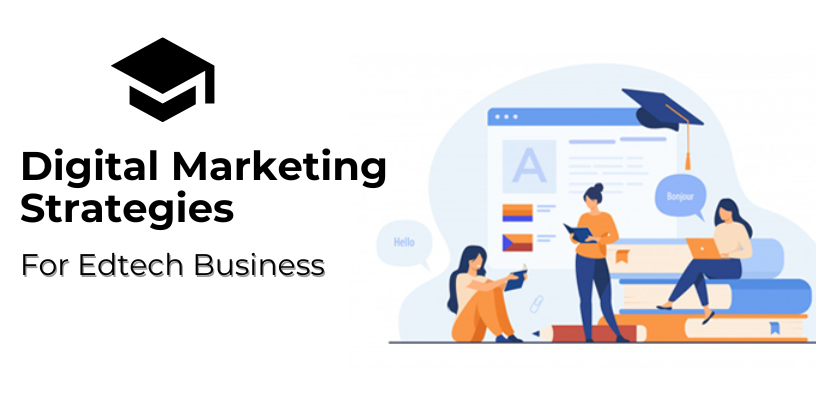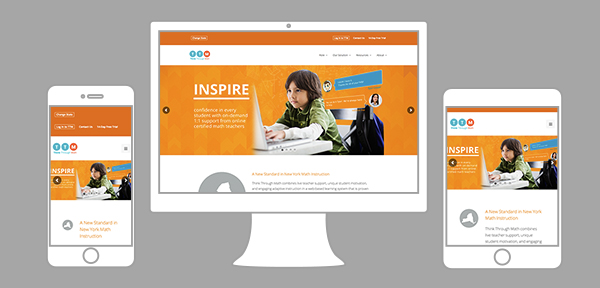
Edtech isn’t just changing how people learn, it’s changing what they expect from the brands behind the learning. If your platform isn’t reaching the right audience or struggling to convert interest into action, the problem usually isn’t the product. It’s the strategy. Digital marketing in the education space can’t rely on generic campaigns or one-size-fits-all tactics. You're speaking to learners, parents, schools, and decision-makers, all with different needs and expectations.
The real challenge?
Reaching them with the right message, at the right time, on the right channel. In a crowded space, visibility alone won’t drive growth. What you need is a strategy rooted in purpose, data, and relevance.
Top Digital Marketing Strategies for Edtech Companies
This post covers the digital marketing strategies that help edtech businesses grow, not just in traffic, but in trust, leads, and long-term impact. If you’re ready to rethink how your brand connects, this is where it starts.
1. Understanding the EdTech Audience

Who Are You Trying to Reach?
EdTech platforms can’t focus on just one type of user. Maybe you’re targeting students aiming for better grades or parents looking for reliable support. Or you might be after professionals who want flexible learning. Some platforms serve schools or bigger institutions, while others speak directly to individual learners. Each group has its motivations, pain points, and expectations.
Why Segmentation Matters?
If you try speaking to everyone with one message, you won't truly connect with anyone. Audience segmentation helps avoid this mess. By grouping users based on their educational needs, goals, or roles, you can deliver messages that resonate with them. Segmentation keeps your content clear and your marketing spend controlled.
One Size Doesn’t Fit All
Each audience needs a different kind of pitch. A parent wants to know about results, safety, and progress tracking. A student cares more about ease, fun, and fast answers. A school might be focused on pricing and integration. Your tone, choice of words, visuals, and even the platforms you advertise on, everything should shift depending on who you're speaking to.
2. Building a Search Optimized Edtech Website

Create an Impressive Edtech Website
Before anyone signs up for a course or books a demo, they’ll visit your website. Whether it's a student scrolling on a phone or a school official using a laptop, they'll expect a clean, modern layout. Your site should load quickly and look good on any screen. Slow or outdated websites create doubt, even if your platform is good. You’re in education, so your presence should reflect that.
Conduct Keyword Research around Educational Search Intent
Start by finding the keywords and phrases that learners and parents search for, like “best coding courses for teens” or “budget-friendly SAT prep.” Tools like SEMrush or Google Keyword Planner reveal specific, long-tail keywords. Pay attention to user intent: are they exploring options (“how to study calculus”) or ready to buy (“enroll in graphic design course”)? Matching your content to these searches grabs attention and boosts your rankings.
Do Local SEO to Target Students from Specific Regions
Trying to reach local audiences? Optimize your content for searches like “STEM workshops in Austin.” Create a Google Business Profile, naturally include location keywords on your site, and get backlinks from local education blogs. This positions your platform as the top choice for nearby learners, attracting focused traffic.
Use Clear Call-to-Action Buttons
When visitors land on your Edtech website or app, they shouldn't have to guess what's next. Clear calls-to-action like “Start Free Trial,” “Book a Demo,” or “View Course Modules” should grab their attention. A smooth sign-up process and simple navigation steps can turn casual browsers into committed users, whether they're students, parents, or schools.
3. Leveraging Content Marketing to Educate and Convert

You’re running an EdTech platform, and content marketing is your secret weapon to attract, educate, and convert learners. Here’s how to make it work.
Create Blog Posts, Case Studies, and Success Stories
Create blog posts answering key questions, like “How can online courses boost your career?” Keep them detailed (around 1,500 words) with clear tips and relatable examples. Highlight case studies about institutions scaling with your tools or learners landing dream jobs. A story of a coder moving from newbie to tech star builds trust. These posts show your expertise and encourage readers to sign up.
Offer Video Explainers and Course Previews
Videos grab attention. Produce short, engaging explainers breaking down tricky topics, like “What’s data science in three minutes?” Offer quick course previews highlighting real lessons or instructor styles. Keep videos brief, under five minutes, with clear visuals and an approachable tone. Share on YouTube or your website to attract visitors and encourage sign-ups.
Create Long-Form, Informative Blog Posts
Write detailed blog posts (around 2,000 words) addressing real concerns, such as “How can my kid excel in online science classes?” Include short, relatable anecdotes, like a student succeeding in chemistry with virtual labs, to spark connections. Organize your content clearly, using descriptive subheads and practical tips. Good content keeps your readers interested, builds their trust, and helps search engines see you as a reliable source.
Using Topic Clusters for Broader Categories
Build content around broad themes like “online learning tools.” Start with a central pillar page, then link to detailed posts like “top apps for math practice” or “virtual study planners.” This approach helps you rank for general terms while addressing specific needs. Strong internal linking guides both users and search crawlers, boosting your authority on the topic.
4. Paid Ads for Driving Targeted Traffic to Your Educational Platform

If you’re launching an EdTech platform, paid ads can put you in front of potential learners fast. Here’s how to use paid ads wisely.
Run Google Search Ads for High-Intent Queries
Reach interested users by running Google Search Ads on targeted searches like “online SAT prep” or “coding bootcamp for beginners.” Write short, clear ads that highlight unique benefits, such as “Ace Your SAT with Live Tutors!” Use negative keywords like “free” to filter irrelevant clicks. Track conversions to understand which ads drive sign-ups and adjust for even better results.
Launch YouTube Ads for Promoting Demo Classes
YouTube’s massive audience makes it an ideal platform for Edtech brands to promote their EdTech solutions. Create short, skippable in-stream ads (under 30 seconds) showcasing demo classes or positive student testimonials. A quick clip of a teen saying, “This course got me into MIT!” catches attention. Target viewers interested in topics like “education” or “career development.” Link your ad to a landing page with a clear call-to-action, boosting demo sign-ups.
Use Meta Ads to Retarget Interested Learners
Visitors don’t always enroll on their first visit. Run Meta ads on Facebook and Instagram targeting users who checked your site but didn’t sign up. Create carousel ads emphasizing course benefits like flexible schedules or experienced instructors. Add urgency with offers like “10% Off This Week!” Use pixel tracking to fine-tune your audience, making sure your ads reach the right users.
5. Social Media Strategy for Building a Learner's Community Online

You’re building an EdTech brand, and social media is your tool to spark conversation and build a vibrant community. Here’s how to do it right.
Focus On Social Media Platforms where Your Learners are
Choose social media platforms where your audience is. For B2B, LinkedIn is the right place. Connect with educators and institutions through thought-provoking posts. For students, Instagram’s visual posts work best. Don’t spread your boundaries. Instead, focus on one or two platforms that fit your audience and business goals.
Post Useful, Non-Promotional Content to Engage Students
Share content that helps, like study tips, industry updates, or fun quizzes, such as “Which Coding Language Suits You?” Create quick polls to spark engagement. Post regularly, three to five times weekly, to keep your audience hooked without overwhelming them.
Partner with Micro-Influencers in Education
Team up with micro-influencers in education, like teachers or student bloggers with 5,000–20,000 followers. Their authentic voice resonates. Ask them to share honest reviews of your courses or co-create content, like a live Q&A. It builds trust and draws their followers toward you.
Build Groups or Forums for Educators
Create spaces for your audience to connect, like a LinkedIn group for educators or a Discord server for students. Encourage discussions on learning challenges or course feedback. Moderate activity to keep it lively and safe. These communities and groups foster loyalty, turning users into advocates.
6. Email Marketing for Nurturing Future Students and Educators

You’ve got EdTech leads, and email marketing can turn them into loyal learners. Here’s how to nurture them effectively.
Segment Learners
Group your leads based on what they’re interested in and what their preferences are. For example, segment those checking out coding from others looking into SAT prep. Use behavior triggers like page visits or quiz completions to tag them. This way, you can send targeted emails, like coding tips to tech fans, that connect and boost engagement.
Automate Communication Flows
Build automation that moves leads step by step. Start with a welcome email for trial sign-ups. Follow with a short series introducing your courses and sharing helpful tips. Then send engaging emails, like study hacks or success stories, to keep them interested. Finish with a personalized upsell, like a discount on a full course. Tools like Mailchimp make it easy to set up.
Write Click-Worthy Emails
Use subject lines that stand out, like “Your Path to Python Mastery Starts Here!” Keep the tone light and friendly, like a friendly conversation. Stick to one clear call-to-action, such as “Join Our Free Webinar.” Add visuals or real student stories to make it feel personal. Test different send times; early mornings usually work well.
7. Collaborations for Strengthening Your Educational Credibility
You’re building an EdTech brand, and smart partnerships can skyrocket your reputation. Here’s how to make it happen.
Partnering with Schools and Platforms
Work with schools, educators, or trusted platforms like Coursera. Offer your courses as part of their programs or create exclusive content together. For example, a coding bootcamp linked to a high school’s STEM program adds instant credibility. These partnerships build trust with both students and parents and show you’re serious about education.
Co-Branded Webinars and Guest Blogs
Team up for co-branded webinars or podcast interviews with well-known educators or EdTech influencers. Imagine a live session with a teacher sharing “Top Study Hacks for Online Learning.” Write guest blogs for popular education sites with tips people can use. These efforts build your authority and connect you with the right audience in a friendly, personal way.
Getting Featured in EdTech Directories
List your platform on EdTech directories or review sites like EdSurge or Capterra. Add a clear description and real user testimonials. Ask happy learners to leave honest reviews. Being featured next to trusted names boosts your visibility and makes it easier for new users to choose your platform.
8. Measuring Success with Data-Driven Insights for EdTech Growth

You’re running an EdTech venture, and data is your key to monitor and measure growth. Here’s how to track and act on what works and what doesn't.
Key Metrics
Track the numbers that show how your business is doing. Customer Acquisition Cost (CAC) tells you what it costs to gain each user. Lifetime Value (LTV) shows how much each user is worth over time. The conversion rate shows how many visitors sign up. Insights indicate who's dropping off. Keep an eye on these to catch patterns, like high churn hinting at weak course engagement, and make quick changes.
Tools to Use
Use Google Analytics to see where your traffic comes from and which pages lead to sign-ups. Mixpanel gives a closer look at how users move through your platform. Hotjar shows heatmaps of where people click or get stuck. Together, these tools help you fine-tune your site and improve your campaigns.
A/B Testing Campaigns
Run A/B tests to see what works. Try two versions of a landing page, one with a bold headline, another with a student testimonial, and track which performs better. Test subject lines, ad images, or buttons, too. Use the results to back the winners and improve your overall marketing. Every test brings you closer to stronger results.
Conclusion:
You’re building an EdTech startup, and the journey’s exciting. From SEO to social media, content to paid ads, each strategy you’ve explored is a tool to connect with learners. Partnerships and data-driven tweaks give you an edge. The key? Test relentlessly, track what works, and refine your approach. Every small win builds momentum, so don’t fear starting lean and learning fast.

Tarun Gupta, CEO of Brainpulse Technologies, is a prolific author and digital marketing specialist. His insightful writings span SEO, content marketing, social media strategy, and email campaigns, offering invaluable expertise to businesses worldwide. Tarun’s contributions continue to shape the digital marketing landscape, guiding success in multiple niches.